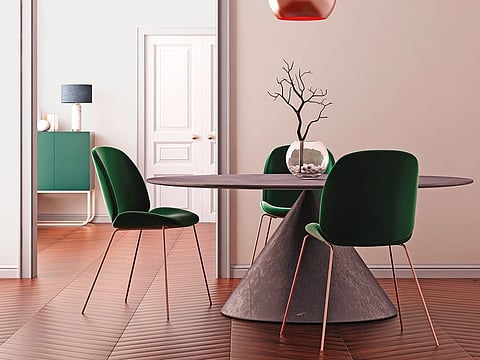Design Diary: Roaring trends for the 2021 home
Pallavi Dean lets us into the key trends that will transform post-pandemic home design

Our collective lockdown experiences will undoubtedly inform the homes of tomorrow (and even today!) Pallavi Dean, the woman behind the award-winning Dubai studio ROAR, lets us into the key trends that will transform post-pandemic home design.
1: Optimism
“We’ve always known that interiors can have a massive impact on moods — that’s our super power as designers! The pandemic has amplified this tenfold, which is why “optimism” is our top trend of 2021” says Dean.
Start with colour. Colour psychology tells us that yellow is the most optimistic hue, with orange and violet close behind. Red and black are a generally a no-no for residential interiors, but green and blue can work if you want a more serene, thoughtful mood. For neutral spaces like floors, walls and ceilings, be wary of brilliant white, which can be sterile; favour off-white, ivory or dove grey.
The other quick win is lighting. Maximise natural light by removing anything that blocks it: curtains or a cupboard are easy, but you might want to dig deeper. Replace a wooden front door with a glass door; replace bulky windows frames with something sleeker. And of course, you can fake it! Floor-to-ceiling mirrors and glossy wall paint bounce natural light around the room, while LED soft white bulbs mimic the midday sun.
2: Earthy, unfinished materials
“We’re spending so much time indoors that we crave the rustic imperfection of nature. Textures are your friend here, with unvarnished wood furniture and accessories the obvious quick win,” she recommends. “Rugs and throws are another off-the-shelf fix, while curtains are a more permanent (and expensive) solution. For maximum impact, hit the walls. Textured paint and wallpaper are fairly straightforward, but you could go all-in with a feature wall clad in natural material like wood, slate, leather or rough-cut marble.”
Then there’s biophilia — the idea of bringing the outside indoors. For plants, go for something like a yucca that has a trunk. And don’t be shy about artificial plants — the effect on your mood is much the same, but with much less hassle.
If you’ve got an outdoor space like a balcony or garden, try to bridge the gap between it and your interiors. That’s not easy — most homes have fixed barriers between these spaces, to defend against thunder storms and 50 degree heatwave. Steal the tricks of restaurant designers, who resolve this dilemma with sliding/folding doors, canopy shades, fans and heaters, to extend the indoor-outdoor season.
A final word on multisensory design. With interiors we think first and foremost visually, but don’t neglect the other senses. Tactility is super important to us (particularly when we’re cooped up during lockdown) and these earthy, unfinished materials are gorgeous to touch. They also help with acoustics by dampening echo. For smell, reach for scented candles or oils. As for taste — look, we interior designers are good, but we ain’t chefs! We can build you a nice kitchen, but you’ve gotta cook the food yourself!
3: Multifunctional Spaces and Cocoon Sanctuaries
“We all need our homes to do a lot more heavy lifting these days. The challenge is to squeeze all of these new experiences into the same space.”
There is only one solution: multifunctional sanctuaries — the two words might not be most likely bedfellows but if you dial it back to the basics, they require the same essentials.
First consider, lighting: find a room or part of a room where you can install dimmer lighting. It could be your bedroom, the bathroom or a corner of the living room.
Second, install comfort-seating that is different to your regular task or dining chairs. A bean bag, a chaise long, an armchair you can sink in to. The point is it must be lean-back seating — not the lean-forward seating we use during the normal day.
Finally, think about sound, smell and touch. So get yourself a speaker to play relaxing music, scented sticks, and a faux fur rug to snuggle up with.
4: Vintage vibes
“There’s a certain comfort in re-connecting with our childhood, hence the residential retro revival.” She’s not suggesting all-out 70s with tie-dyed wallpaper; rather, subtle vintage accents to add real character. For example: vinyl record players, PAC-MAN arcade machine or some retro geometry in art. A close cousin is using the theory of Vuja de — seeing the familiar with a fresh view.
5: Hack your space
“Our final transformative trend for 2021 is hacking — that is, quick changes you can do in a weekend, rather than a full refit,” she signs off. “Look, we all hope the current reality of on-off lockdowns and home schooling — wherever we live in the world — is a temporary rather than permanent thing. A short-term problem requires short-term solutions — hence the focus on quick-and-easy hacks.”
Sign up for the Daily Briefing
Get the latest news and updates straight to your inbox





